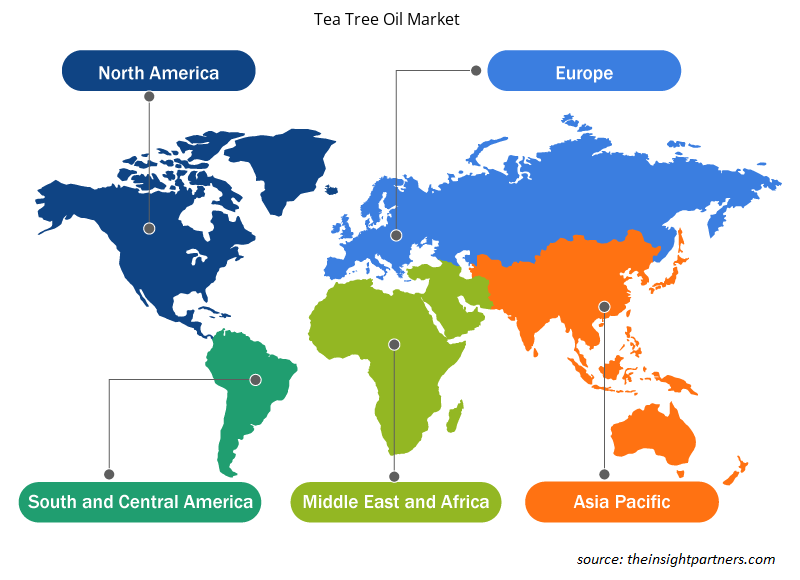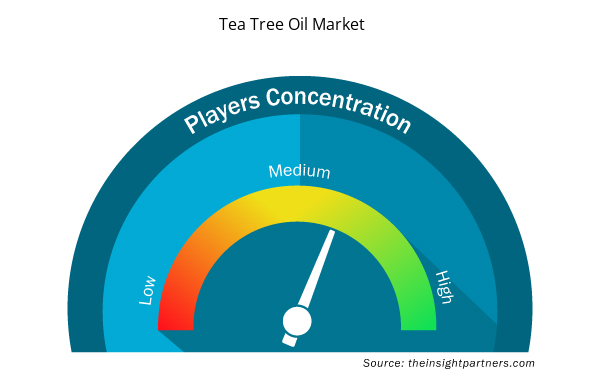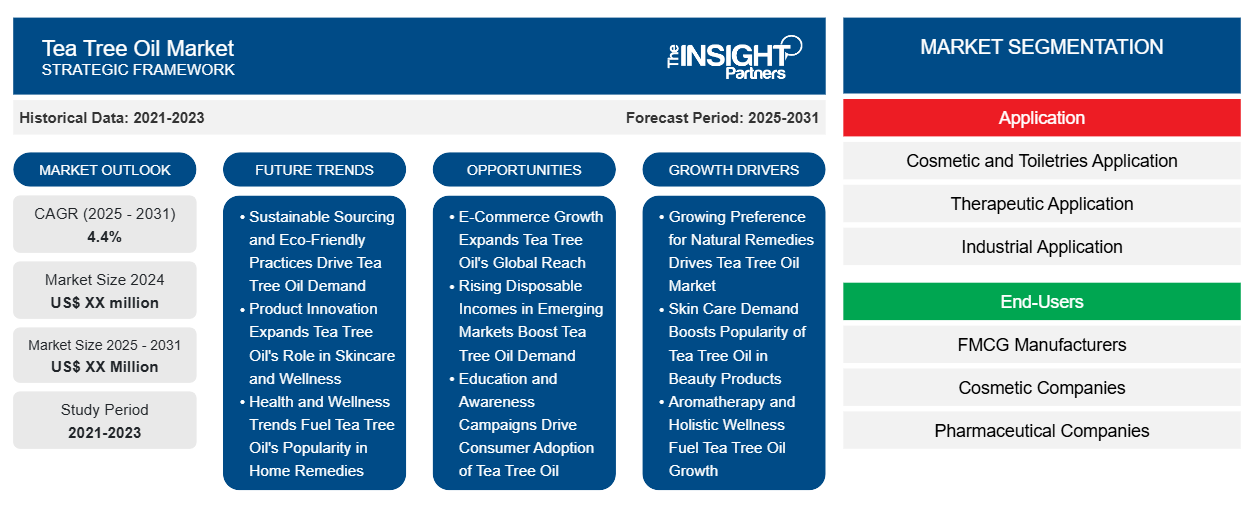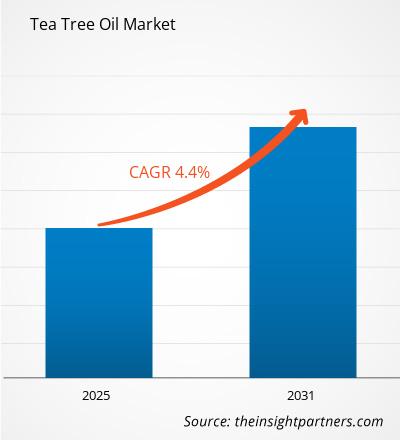Se espera que el mercado de aceite de árbol de té registre una CAGR del 4,4% entre 2023 y 2031, con un tamaño de mercado que se expandirá de US$ XX millones en 2023 a US$ XX millones en 2031.
El informe está segmentado por aplicación (aplicación cosmética y de tocador, aplicación terapéutica y aplicación industrial). El informe está segmentado por usuarios finales (fabricantes de bienes de consumo masivo, empresas cosméticas, compañías farmacéuticas y otros). El informe presenta además un análisis basado en el grado (grado farmacéutico/cosmético, grado terapéutico). El alcance del informe cubre cinco regiones: América del Norte, Europa, Asia Pacífico, Medio Oriente y África, y América del Sur y Central y los países clave de cada región. El análisis global se desglosa aún más a nivel regional y por países principales. El informe ofrece el valor en USD para el análisis y los segmentos anteriores.
Propósito del Informe
El informe Tea Tree Oil Market de The Insight Partners tiene como objetivo describir el panorama actual y el crecimiento futuro, los principales factores impulsores, los desafíos y las oportunidades. Esto proporcionará información a diversas partes interesadas del negocio, como:
- Proveedores/fabricantes de tecnología: Para comprender la dinámica cambiante del mercado y conocer las oportunidades potenciales de crecimiento, lo que les permitirá tomar decisiones estratégicas informadas.
- Inversionistas: Realizar un análisis exhaustivo de tendencias sobre la tasa de crecimiento del mercado, las proyecciones financieras del mercado y las oportunidades que existen en toda la cadena de valor.
- Órganos reguladores: Regular las políticas y vigilar las actividades del mercado con el objetivo de minimizar los abusos, preservar la confianza de los inversores y defender la integridad y la estabilidad del mercado.
Segmentación del mercado del aceite de árbol de té
Solicitud
- Aplicación en cosméticos y artículos de tocador
- Aplicación terapéutica
- Aplicación industrial
Usuarios finales
- Fabricantes de bienes de consumo masivo
- Empresas de Cosmética
- Compañías farmacéuticas
Calificación
- Grado farmacéutico/cosmético y grado terapéutico
Geografía
- América del norte
- Europa
- Asia-Pacífico
- América del Sur y Central
- Oriente Medio y África
Geografía
- América del norte
- Europa
- Asia-Pacífico
- América del Sur y Central
- Oriente Medio y África
Personalice este informe según sus necesidades
Obtendrá personalización en cualquier informe, sin cargo, incluidas partes de este informe o análisis a nivel de país, paquete de datos de Excel, así como también grandes ofertas y descuentos para empresas emergentes y universidades.
- Obtenga las principales tendencias clave del mercado de este informe.Esta muestra GRATUITA incluirá análisis de datos, desde tendencias del mercado hasta estimaciones y pronósticos.
Factores impulsores del crecimiento del mercado del aceite de árbol de té
- La creciente preferencia por los remedios naturales impulsa el mercado del aceite de árbol de té: uno de los principales impulsores del crecimiento del mercado del aceite de árbol de té es la preferencia por los remedios naturales. La mayor conciencia sobre la salud y el bienestar entre los consumidores los ha llevado a elegir productos orgánicos o naturales para satisfacer sus necesidades de salud. El aceite de árbol de té es un producto antibacteriano y antifúngico que se utiliza principalmente en el tratamiento de problemas relacionados con la piel y el bienestar general.
- La demanda de productos para el cuidado de la piel aumenta la popularidad del aceite de árbol de té en los productos de belleza: la principal fuerza detrás de la demanda de aceite de árbol de té son los productos para el cuidado de la piel, ya que los consumidores ahora buscan ingredientes naturales en sus rutinas de cuidado. La demanda de aceite de árbol de té también proviene del hecho de que cura el acné y las imperfecciones, entre otros problemas de la piel. La búsqueda de productos de belleza limpios y la búsqueda de productos limpios llevaron a una mayor demanda de mucho más aceite de árbol de té que el que se utiliza en todo tipo de fórmulas.
- La aromaterapia y el bienestar holístico impulsan el crecimiento del aceite de árbol de té: el principal impulsor del crecimiento del mercado del aceite de árbol de té es la aromaterapia, que, con el aumento de la práctica del bienestar holístico entre los consumidores, ha ido ganando popularidad a medida que sus propiedades calmantes se utilizan ampliamente en mezclas y difusores de aceites esenciales. Este interés en los sectores del bienestar mental y emocional aumenta el atractivo del producto.
Tendencias futuras del mercado del aceite de árbol de té
- El abastecimiento sostenible y las prácticas respetuosas con el medio ambiente impulsan la demanda de aceite de árbol de té: el abastecimiento sostenible de aceite de árbol de té se ha vuelto muy común en estos días, donde los consumidores exigen productos ecológicos. Ahora hay más marcas que prefieren aceites de árbol de té cosechados éticamente y centrados en la responsabilidad ambiental, el comercio justo y otros aspectos. Todo este compromiso con la sostenibilidad fomenta la lealtad y genera confianza en los clientes conscientes del medio ambiente que buscan productos naturales de calidad.
- La innovación de productos amplía el papel del aceite de árbol de té en el cuidado de la piel y el bienestar: la innovación de productos en el mercado del aceite de árbol de té tiene que ver con el desarrollo de nuevas fórmulas mediante las cuales las marcas incorporan este producto en productos para el cuidado de la piel, el cabello o el bienestar. Las innovaciones en cremas, sueros y limpiadores con infusión de aceite de árbol de té aumentan las necesidades de los consumidores. Por lo tanto, esto hace que el aceite de árbol de té sea un ingrediente multifuncional atractivo.
- Las tendencias de salud y bienestar impulsan la popularidad del aceite de árbol de té en los remedios caseros: la tendencia en materia de salud y bienestar ha llegado muy lejos en el mercado del aceite de árbol de té, donde los clientes buscan alternativas naturales para los remedios caseros y el cuidado personal. El aceite de árbol de té está ganando notoriedad rápidamente por su naturaleza antiséptica, de ahí su adopción en muchas fórmulas de limpieza y bienestar. Esto ayudará a estimular y mejorar la vida holística y una solución de salud natural.
Oportunidades de mercado del aceite de árbol de té
- E-Commerce Growth Expands Tea Tree Oil's Global Reach: E-commerce is an opportunity for tea tree oil. Online platforms increase the reach of brands to a global level and offer a convenient accessibility of products. Improving digital marketing strategies attract a diversified population of consumers, and thus, create brand loyalty and sales. The current trend turns in favor of customers' preferences in online shopping.
- Rising Disposable Incomes in Emerging Markets Boost Tea Tree Oil Demand: More expansion scope of tea tree oil brands is a relatively new emerging market. Increasing disposable incomes in Asia and Latin America bring forth new potential customer bases due to growing awareness about natural health products. Provided that marketing schemes are adapted according to regional consumer preferences, such a brand will easily gain visibility and generate sales in those markets.
- Education and Awareness Campaigns Drive Consumer Adoption of Tea Tree Oil: Education and awareness about benefits and uses can play a key role in pushing growth in the market for tea tree oil. Awareness campaigns where use of the property as an antimicrobial agent along with its multifarious uses are done will greatly enhance understanding among consumers. Brands can promote more usage by empowering customers, build a loyalty pool that's focused on natural solutions.
Tea Tree Oil Market Regional Insights
The regional trends and factors influencing the Tea Tree Oil Market throughout the forecast period have been thoroughly explained by the analysts at Insight Partners. This section also discusses Tea Tree Oil Market segments and geography across North America, Europe, Asia Pacific, Middle East and Africa, and South and Central America.

- Get the Regional Specific Data for Tea Tree Oil Market
Tea Tree Oil Market Report Scope
| Report Attribute | Details |
|---|---|
| Market size in 2023 | US$ XX million |
| Market Size by 2031 | US$ XX Million |
| Global CAGR (2023 - 2031) | 4.4% |
| Historical Data | 2021-2022 |
| Forecast period | 2024-2031 |
| Segments Covered | By Application
|
| Regions and Countries Covered | North America
|
| Market leaders and key company profiles |
|
Tea Tree Oil Market Players Density: Understanding Its Impact on Business Dynamics
El mercado del aceite de árbol de té está creciendo rápidamente, impulsado por la creciente demanda de los usuarios finales debido a factores como la evolución de las preferencias de los consumidores, los avances tecnológicos y una mayor conciencia de los beneficios del producto. A medida que aumenta la demanda, las empresas amplían sus ofertas, innovan para satisfacer las necesidades de los consumidores y aprovechan las tendencias emergentes, lo que impulsa aún más el crecimiento del mercado.
La densidad de actores del mercado se refiere a la distribución de las empresas o firmas que operan dentro de un mercado o industria en particular. Indica cuántos competidores (actores del mercado) están presentes en un espacio de mercado determinado en relación con su tamaño o valor total de mercado.
Las principales empresas que operan en el mercado del aceite de árbol de té son:
- Aos Producto Pvt. Ltd.
- Compañía de aceite de árbol de té de las montañas Coromandel
- GR Davis P/L
- Integria Healthcare (Australia) Pty Ltd.
- Jenbrook Pty Ltd
Descargo de responsabilidad : Las empresas enumeradas anteriormente no están clasificadas en ningún orden particular.

- Obtenga una descripción general de los principales actores clave del mercado de aceite de árbol de té
Puntos de venta clave
- Cobertura integral: el informe cubre de manera integral el análisis de productos, servicios, tipos y usuarios finales del mercado de aceite de árbol de té, proporcionando un panorama holístico.
- Análisis de expertos: el informe se compila sobre la base de un profundo conocimiento de expertos y analistas de la industria.
- Información actualizada: El informe asegura relevancia comercial debido a su cobertura de información reciente y tendencias de datos.
- Opciones de personalización: este informe se puede personalizar para satisfacer los requisitos específicos del cliente y adaptarse adecuadamente a las estrategias comerciales.
Por lo tanto, el informe de investigación sobre el mercado del aceite de árbol de té puede ayudar a abrir camino para descifrar y comprender el escenario de la industria y las perspectivas de crecimiento. Si bien puede haber algunas preocupaciones válidas, los beneficios generales de este informe tienden a superar las desventajas.
- Análisis histórico (2 años), año base, pronóstico (7 años) con CAGR
- Análisis PEST y FODA
- Tamaño del mercado Valor/volumen: global, regional, nacional
- Industria y panorama competitivo
- Conjunto de datos de Excel



Report Coverage
Revenue forecast, Company Analysis, Industry landscape, Growth factors, and Trends

Segment Covered
This text is related
to segments covered.

Regional Scope
North America, Europe, Asia Pacific, Middle East & Africa, South & Central America

Country Scope
This text is related
to country scope.
Preguntas frecuentes
Demand for ethically sourced tea tree oil reflects consumer interest in eco-friendly products is expected to be the key market trend
The report can be delivered in PDF/Word format, we can also share excel data sheet based on request.
On the basis of geography, the tea tree oil market is classified into North America, Europe, Asia Pacific, Middle East and Africa, and South and Central America
Jenbrook Pty Ltd, Maria River Plantation, T.G.Cassegrain & Co Pty Ltd, Coromandel Mountains Tea Tree Oil Co, The Lebermuth Co Inc, Aos Product Pvt. Ltd, Young Living Essential Oils, Cape Mountain Oils, TeaTreeTherapy, True Blue Organics
The Tea Tree Oil Market is estimated to witness a CAGR of 4.4% from 2023 to 2031
The major factors driving the tea tree oil market are:
1. Rising preference for natural products boosts demand for tea tree oil's antibacterial properties.
2. Increased interest in holistic wellness encourages tea tree oil use in aromatherapy.
Trends and growth analysis reports related to Consumer Goods : READ MORE..
1.Aos Product Pvt. Ltd.
2.Coromandel Mountains Tea Tree Oil Company
3.G.R. Davis P/L
4.Integria Healthcare (Australia) Pty Ltd.
5.Jenbrook Pty Ltd
6.MAIN CAMP NATURAL EXTRACTS PTY LTD
7.Maria River Plantation
8.Naturally Australian Tea Tree Oil Pty Ltd
9.Oribi Oils (Pty) Ltd.
10.T.G.Cassegrain and Co Pty Ltd
The Insight Partners performs research in 4 major stages: Data Collection & Secondary Research, Primary Research, Data Analysis and Data Triangulation & Final Review.
- Data Collection and Secondary Research:
As a market research and consulting firm operating from a decade, we have published and advised several client across the globe. First step for any study will start with an assessment of currently available data and insights from existing reports. Further, historical and current market information is collected from Investor Presentations, Annual Reports, SEC Filings, etc., and other information related to company’s performance and market positioning are gathered from Paid Databases (Factiva, Hoovers, and Reuters) and various other publications available in public domain.
Several associations trade associates, technical forums, institutes, societies and organization are accessed to gain technical as well as market related insights through their publications such as research papers, blogs and press releases related to the studies are referred to get cues about the market. Further, white papers, journals, magazines, and other news articles published in last 3 years are scrutinized and analyzed to understand the current market trends.
- Primary Research:
The primarily interview analysis comprise of data obtained from industry participants interview and answers to survey questions gathered by in-house primary team.
For primary research, interviews are conducted with industry experts/CEOs/Marketing Managers/VPs/Subject Matter Experts from both demand and supply side to get a 360-degree view of the market. The primary team conducts several interviews based on the complexity of the markets to understand the various market trends and dynamics which makes research more credible and precise.
A typical research interview fulfils the following functions:
- Provides first-hand information on the market size, market trends, growth trends, competitive landscape, and outlook
- Validates and strengthens in-house secondary research findings
- Develops the analysis team’s expertise and market understanding
Primary research involves email interactions and telephone interviews for each market, category, segment, and sub-segment across geographies. The participants who typically take part in such a process include, but are not limited to:
- Industry participants: VPs, business development managers, market intelligence managers and national sales managers
- Outside experts: Valuation experts, research analysts and key opinion leaders specializing in the electronics and semiconductor industry.
Below is the breakup of our primary respondents by company, designation, and region:

Once we receive the confirmation from primary research sources or primary respondents, we finalize the base year market estimation and forecast the data as per the macroeconomic and microeconomic factors assessed during data collection.
- Data Analysis:
Once data is validated through both secondary as well as primary respondents, we finalize the market estimations by hypothesis formulation and factor analysis at regional and country level.
- Macro-Economic Factor Analysis:
We analyse macroeconomic indicators such the gross domestic product (GDP), increase in the demand for goods and services across industries, technological advancement, regional economic growth, governmental policies, the influence of COVID-19, PEST analysis, and other aspects. This analysis aids in setting benchmarks for various nations/regions and approximating market splits. Additionally, the general trend of the aforementioned components aid in determining the market's development possibilities.
- Country Level Data:
Various factors that are especially aligned to the country are taken into account to determine the market size for a certain area and country, including the presence of vendors, such as headquarters and offices, the country's GDP, demand patterns, and industry growth. To comprehend the market dynamics for the nation, a number of growth variables, inhibitors, application areas, and current market trends are researched. The aforementioned elements aid in determining the country's overall market's growth potential.
- Company Profile:
The “Table of Contents” is formulated by listing and analyzing more than 25 - 30 companies operating in the market ecosystem across geographies. However, we profile only 10 companies as a standard practice in our syndicate reports. These 10 companies comprise leading, emerging, and regional players. Nonetheless, our analysis is not restricted to the 10 listed companies, we also analyze other companies present in the market to develop a holistic view and understand the prevailing trends. The “Company Profiles” section in the report covers key facts, business description, products & services, financial information, SWOT analysis, and key developments. The financial information presented is extracted from the annual reports and official documents of the publicly listed companies. Upon collecting the information for the sections of respective companies, we verify them via various primary sources and then compile the data in respective company profiles. The company level information helps us in deriving the base number as well as in forecasting the market size.
- Developing Base Number:
Aggregation of sales statistics (2020-2022) and macro-economic factor, and other secondary and primary research insights are utilized to arrive at base number and related market shares for 2022. The data gaps are identified in this step and relevant market data is analyzed, collected from paid primary interviews or databases. On finalizing the base year market size, forecasts are developed on the basis of macro-economic, industry and market growth factors and company level analysis.
- Data Triangulation and Final Review:
The market findings and base year market size calculations are validated from supply as well as demand side. Demand side validations are based on macro-economic factor analysis and benchmarks for respective regions and countries. In case of supply side validations, revenues of major companies are estimated (in case not available) based on industry benchmark, approximate number of employees, product portfolio, and primary interviews revenues are gathered. Further revenue from target product/service segment is assessed to avoid overshooting of market statistics. In case of heavy deviations between supply and demand side values, all thes steps are repeated to achieve synchronization.
We follow an iterative model, wherein we share our research findings with Subject Matter Experts (SME’s) and Key Opinion Leaders (KOLs) until consensus view of the market is not formulated – this model negates any drastic deviation in the opinions of experts. Only validated and universally acceptable research findings are quoted in our reports.
We have important check points that we use to validate our research findings – which we call – data triangulation, where we validate the information, we generate from secondary sources with primary interviews and then we re-validate with our internal data bases and Subject matter experts. This comprehensive model enables us to deliver high quality, reliable data in shortest possible time.


 Obtenga una muestra gratuita de este informe
Obtenga una muestra gratuita de este informe